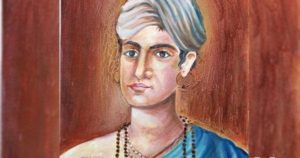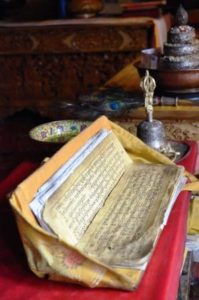Amongst all Samhita i.e. Brihattrayi and Laghutrayi, Ashtanga Hridaya has got the wide acceptance in the Vaidya community. Ashtanga Hridaya is considerd as the essence of Ashtanga Sangraha. It is mentioned in Ashtanga Sangraha itself that the description in Ashtanga Sangraha is the compilation work based on Sushrutsamhita and Charakasamhita. Ashtanga Sangraha is placed in the first half of 7 th century by historians.Ashtanga Hridaya is considered to be a work of second half of 7 th century. Ashtanga Hridaya has its own advantages over Ashtanga Sangraha. The way Ashtanga Hridaya has been written it shows the expertise of Vagbhata in Ayurveda, Sanskrit and Poetry.
Acharya Vagbhata
 Vagbhata was the son of Simhagupta. His grandfather too was known by the same name i.e. Vagbhata. He is believed to hail from the region of river Sindhu. His father and grandfather, both were great Ayurvedic scholars Vagbatta is said to be the disciple of Avalokita. Vagbhata was the author of 2 great treatises of Ayurveda namely ‘Ashtanga Sangraha’ and ‘Ashtanga Hridaya’. Vagbhata is famous for having presented Ayurveda and its essence in an easy, simple, comprehensive and understandable way.
Vagbhata was the son of Simhagupta. His grandfather too was known by the same name i.e. Vagbhata. He is believed to hail from the region of river Sindhu. His father and grandfather, both were great Ayurvedic scholars Vagbatta is said to be the disciple of Avalokita. Vagbhata was the author of 2 great treatises of Ayurveda namely ‘Ashtanga Sangraha’ and ‘Ashtanga Hridaya’. Vagbhata is famous for having presented Ayurveda and its essence in an easy, simple, comprehensive and understandable way.
 Even Ashtanga Hridaya was written as a most contemporary Samhita in that era. The history of Ayurveda is divided into 4 sections i.e. Vaidika Kala, Samhita Kala, Sangraha Kala and Madhya Kala. Ashtanga Hridaya falls in the third section i.e Sangraha Kala. Still Ashtanga Hridaya has surmounted the literature of all the Kala and proved its importance.
Even Ashtanga Hridaya was written as a most contemporary Samhita in that era. The history of Ayurveda is divided into 4 sections i.e. Vaidika Kala, Samhita Kala, Sangraha Kala and Madhya Kala. Ashtanga Hridaya falls in the third section i.e Sangraha Kala. Still Ashtanga Hridaya has surmounted the literature of all the Kala and proved its importance.
It’s easy to understand language makes it more acceptable amongst all the disciples of Ayurveda. The arrangement of subject matter in various sections is appropriate. Whenever a particular topic is discussed, it is discussed thoroughly and in detail and hence that subject will not be mentioned elsewhere. Use of various Chandas makes it very easy for the students to recite the Shloka from Ashtanga Hridaya as compared to other Samhita.
Ashtanga Hridaya contains about 7120 poetic verses. Mainly focussing on kayachikitsa, Ashtanga Hridaya also discusses in detail about various surgical treatments. The kapha subtypes are first listed and described in this samhita, with exhaustive explanation of vata, pitta, and kapha along with their five subtypes.This text is considered as a combined form of both the Atreya and Dhanwanthari schools. Many of the ayurvedic medicines are prepared through the methods described in Ashtanga Hridaya.
Ashtanga Hridya Samhita is divided into sutra , nidana, sharira, chikitsa, kalpa, and uttara sthana, and was also written by Vagbhata. It contains 120 chapters and the author quotes Charaka, Susruta Bhela, Nimi, Kasyapa, Dhanvantari and other earlier authors and their works; the chief source, however, is Ashtanga Samgraha. It s a complete but concise description of Ayurvedic medicine.
Ashtanga Hridaya Samhita has catalogued, a systematized text of human illnesses. It is the third major treatise in Ayurveda. Astanga Hridaya focuses more on the physiological aspect of the body rather than the spiritual aspects of it.
Ashtanga Samgraha and Ashtanga Hridya, particularly the latter, indicate advancement in knowledge over the two samhitas of Charaka and Susruta. This is particularly noticeable in the new drugs and some of the new surgical procedures that have been introduced.
Ashtanga Hridaya (Ashta = 8; Anga = Organ) deals with the 8 angas or organs of the body. namely:
- Kaya Chikitsa – Treatment of the body.
- Baala Chikitsa – Section on pediatrics
- Griha Chikitsa – Section on psychiatry
- Urdhvanga Chikitsa or Shalakya Tantra – Treatment for eye, ear, nose and parts above neck
- Salya Tantra – Section on surgery
- Damsthra Chikitsa – Section on Toxicology
- Jara Chikitsa or Rasayana Chikitsa – Rejuvenation Therapy
- Vrishya chikitsa or Vajeekarana Chikitsa – Aphrodisiac Therapy
In Kerala ,a state in the south part of India, Ashtanga vaidyas are highly respected and consulted. Ashta Vaidyas were Ayurvedic practitioners well-versed in all the eight different branches of Ayurvedic treatment. Kerala is now known for its Ayurvedic centers mainly because of the Ashta Vaidyas.
Image Countresy:Easy Ayurveda
You may also like
-
India Against Mpox
-
Combination of ‘Siddha’ Drugs Reduces Anemia in Adolescent Girls: Study
-
Suspected Mpox Case Under Investigation; Patient Put Under Isolation, No Cause for Alarm
-
Prime Minister Applauds India’s Best Ever Performance at the Paralympic Games
-
National Exit Test (NExT) for Ayush to be Effective from 2021-2022 Batch: Union Minister of Ayush Shri Prataprao Jadhav
